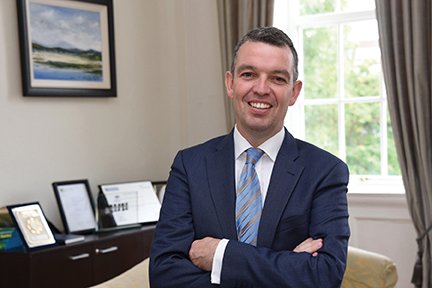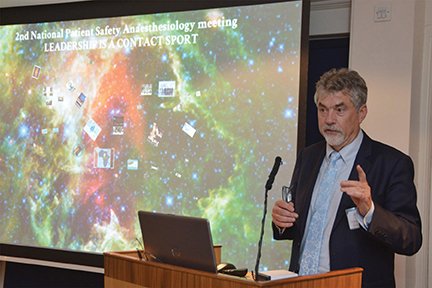Members of the College of Anaesthesiologists of Ireland outline the critical role of anaesthesiology and how anaesthesiologists can play a major part in patient safety in advance of World Patient Safety Day
The College of Anaesthesiologists of Ireland (CAI) has endorsed the establishment of World Patient Safety Day to be observed annually on 17 September. This is a World Health Organisation (WHO) initiative to raise global awareness about patient safety.
The WHO definition of patient safety is “the absence of preventable harm to a patient during the process of health care and reduction of risk of unnecessary harm associated with health care to an acceptable minimum”. An “acceptable minimum” refers to the collective notions of given current knowledge, resources available and the context in which care was delivered, weighed against the risk of non-treatment or other treatment.
“Patient safety is at the core of everything we do in the College and not surprisingly, is embedded in our College motto, Salus Dum Vigilamus, which is translated to ‘safety while we watch’”, according to President of the CAI Dr Brian Kinirons.
“Anaesthesiologists form the largest single hospital medical specialty and their skills are used in all aspects of patient care.”

Whilst the perioperative anaesthetic care of the surgical patient is the core of the specialty, many anaesthesiologists have a much wider scope of practice, which may include:
The preoperative preparation of surgical patients.
The resuscitation and stabilisation of patients in the emergency department.
Pain relief in labour and obstetric anaesthesia.
Intensive care medicine.
Transport of acutely ill and critically injured patients.
Pre-hospital emergency care.
Pain medicine, including:
The relief of acute postoperative pain.
Chronic and cancer pain management.
The provision of sedation and anaesthesia for patients undergoing various procedures outside the operating theatre. Examples of this include endoscopic procedures, interventional radiology and dental surgery.
“Every point in the process of care-giving contains a certain degree of inherent risk, and anaesthesiologists are uniquely positioned to play a leading role in improving both patient safety and quality of care,” according to Dr Kinirons.
Despite the benefits of rapidly-advancing therapeutic and diagnostic modalities the perioperative setting still exposes patients to significant risks of adverse events and harm.
Anaesthesiologists can make significant contributions, particularly as perioperative clinical leaders, to protect patient safety and improve patient outcomes.
Surgery is an important treatment option for a wide range of acute and chronic diseases, with thousands of patients having procedures annually in Ireland. For most patients, surgery is a success, both in terms of the procedure itself and the care before and afterwards.
Serious incidents
However, across the world, as many as
one-in-four patients are harmed whilst receiving primary and ambulatory
healthcare. Recent figures published in The Irish Times (editorial, 14 August 2019) indicates
that 35 per cent of serious incidents which involve harm or death to patients
were notified within 24 hours, as required, to a senior, accountable member of
staff. Half of all incidents are entered into the HSE’s electronic database within
the proscribed time scale of 30 days. Whether or not these incidents were
preventable, they need to be investigated so repeat events can, if
possible, be avoided. Just as the population is changing, so must services so
as to improve patient safety.
In addition, with a growing number of patients now on waiting lists, the number of patients at higher risk from surgery is set to rise. So with greater demand and the increasing complexity of surgical procedures, come new patient safety challenges that must be addressed. Adverse events and patient harm continue to be frequent in the perioperative period. Adverse events occur in about 30 per cent of hospital admissions, are associated with higher mortality, and may be preventable in more than 50 per cent of patients. Evidence-based recommendations are available for many patient safety issues.
Over the past decades, the risks associated with anaesthesia have been dramatically reduced; however, from a patient’s perspective, anaesthesia-specific risks cannot be meaningfully isolated from perioperative and peri-interventional risks. No single risk-free pathway exists, but promising targets include the prevention of perioperative infections and of complications of airway and respiratory management.
The College of Anaesthesiologists of Ireland regards the promotion of excellence in patient safety and quality of care as its core strategic objective over the next five years.
Quality and safety
From a governance perspective, to increase the focus on quality and safety, the CAI Council established the Quality and Safety Advisory (QSA) committee, a standing committee of the College charged with promoting and maintaining a culture of patient safety, providing leadership for patient safety in anaesthesia and providing timely information to support patient safety.
Dr Kevin Clarkson, who chairs the QSA committee, believes that clear policies, organisational leadership capacity, data to drive safety improvements, skilled healthcare professionals and effective involvement of patients in their care are all needed to ensure sustainable and significant improvements in the safety of healthcare.
He goes on to explain some specific innovations that CAI has made to improve patient safety and quality of care.
Embedding patient safety in specialist training programmes
The CAI has recently completed a comprehensive review of its training programme for specialist anaesthesiologists and has incorporated key aspects of the WHO patient safety curriculum.
In addition, the CAI has invested heavily in high-fidelity, award-winning simulation facilities that play an essential role in clinical education and training at all levels and across all disciplines.
Simulation-based training within healthcare provides a safe learning area for both technical and non-technical skills. It is a well-established method of education in anaesthesiology — showing efficacy, with retention demonstrated up to one-year post-simulated exposure. The College has been at the vanguard of making participation in simulation a core part of the educational programme for its trainees. According to Prof Crina Burlacu, Director of Simulation in CAI, “over a six-year training period, our trainees will experience some 10 different simulation courses. By training for rare or critical events in the safe environment of a simulation laboratory, our trainees will be better placed to respond to real-life crisis, should they occur.”
More recently in 2018, Prof Crina Burlacu and her team of Simulation Fellows at St Vincent’s University Hospital and CAI created an intensive three half-day boot camp for new anaesthesiology trainees that the participants felt improved their work practices. This induction boot camp is now being delivered at five clinical sites around Ireland annually.
Caring for the carers
The CAI is official campaign backer of the Association of Anaesthetists of Great Britain and Ireland #fightfatigue initiative, designed to address the impact of fatigue and shift-working on doctors and the consequences for wellbeing and patient safety.
This follows a recent survey of 240 doctors in specialist anaesthesiology training, which found that 70 per cent of SAT trainees had been involved in or witnessed a crash or near miss when driving home after a night shift.
“Safer person-centered care starts with caring for the people who provide care for others,” said Mr Martin McCormack, CEO of the CAI, and “we need to treat our doctors in the same way we want them to treat their patients to support safer patient care”.
“We need collectively, as a system, to respect the dedication of those who work in healthcare in Ireland, and more especially their quality improvement work with respect to patient safety,” he added.
“We have updated our accreditation process of clinical training sites to identify areas of improvement that will support improved patient safety — like access to food after 6pm and at the weekend, and access to on-shift and post-shift rest facilities.

“Regular, proper rest breaks are mandatory and failure to provide them is a failure of organisational responsibility and neglects the needs of staff. We need to make our doctors feel cared for and valued. Doing this will result in enhanced safety for both doctors and patients.”
Building a patient safety ecosystem
Prof Gerry Fitzpatrick, Vice President of the CAI and Chair of the Forum of Postgraduate Training Bodies Quality and Risk Committee, is leading the development of a Safe Anaesthesia Network in Ireland (SANI) and has proactively developed links with HIQA, Health Products Regulatory Authority (HPRA), the State Claims Agency, the National Patient Safety Office, and the Quality improvement division in the HSE on behalf of the CAI. The objective is to ensure open communications between all elements of the system in relation to safety issues and also to establish ‘Safety Leads’ in each department of anaesthesiology around the country.

Since its inception in 2017, the National Patient Safety in Anaesthesia Conference organised by the CAI is an unmissable event, with this year’s conference taking place on 15 November in the CAI. This year’s conference themes supporting patient safety include incident-reporting and the Patient Safety Bill, with speakers from the National Patient Safety Office, HPRA, HIQA, State Claims Agency and international speakers, such as Prof Ravi Mahajan, President of the Royal College of Anaesthetists.
Leadership
To mark World Patient Safety Day 2019, Dr Kinirons is pleased to announce that the Council of CAI have approved the appointment of a clinical lead in patient safety to take up post in January 2020 and who will play a leadership role in advocating for policy changes to support patient safety nationally and internationally. This person will also be responsible for ensuring that all CAI activities are aligned with the Safety Strategy. Recruitment for this post will commence shortly.
Data to drive safety improvements
Dr Kinirons also praises the work of the National Clinical Programme in Anaesthesia and the Healthcare Pricing Office, which under Dr John Cahill and Dr Jeremy Smith’s stewardship has developed a repository of data and support audit to drive safety improvements.
Global health
The CAI’s commitment to patient safety has a global reach. “We have a responsibility to collaborate with international partners to increase access to safe anaesthesia to all those who need it,” said Dr Kinirons. “Poor-quality healthcare around the globe causes ongoing damage to human health. In low- and middle-income countries (LMICs), between 5.7 and 8.4 million deaths occur each year from poor quality of care, which means that quality defects cause 10-to-15 percent of the total deaths in these countries.”
“Our education and training programme in Malawi has equipped over 700 healthcare practitioners with the skills and evidence base to improve patient safety, to dramatic effect.”
Whilst a move toward universal health coverage is the central theme of global health policy today, the fact is that even if such a movement succeeds, billions of people will have access to care of such low quality that it will not help them — and indeed, often will harm them. Without deliberate, comprehensive efforts to improve patient safety and the quality of healthcare globally, universal health coverage will be meaningless.
“CAI are committed to harnessing the support of our patient safety ecosystem to deliver initiatives in low- and middle-income countries in line with the Lancet Commission findings and UN sustainable development goals to improve access to safer anaesthesia and support improvements in patient safety globally.”
This article was produced by the College of Anaesthesiologists.
Patient safety – facts and figures
Magnitude
As many as one-in-four patients are harmed whilst receiving primary and ambulatory care.
Source: The economics of patient safety in primary and ambulatory care- Flying blind (OECD study) 2018
Incidence
134 million adverse events occur each year in hospitals in low- and middle-income countries, contributing to 2.6 million deaths annually due to unsafe care.
Source: Crossing the global quality chasm: Improving health care worldwide, The National Academies of Sciences Engineering & Medicine (2018).

